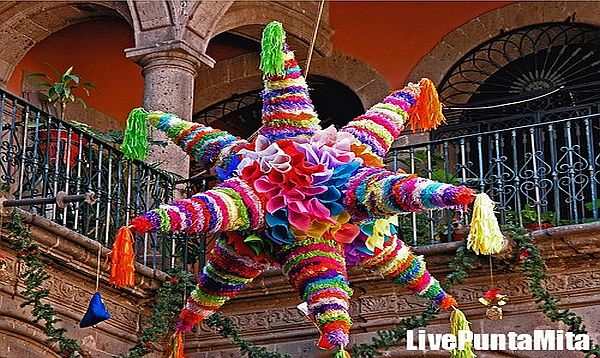Puerto Vallarta, Mexico - In Mexico a piñata accompanies almost every fiesta, holiday or birthday celebration. A piñata is made of papier-mâché, with a clay pot or olla de barro on the inside filled with toys, fruit and candy.
It is suspended from above and moved around while blindfolded children and (sometimes for stress relief, adults!) are spun around as they try hitting it with a stick in order to break it apart for all the goodies inside as part of a ceremony or celebration.
Piñatas were brought to Mexico from Europe in the 16th century, however, traditionally the Aztecs had a similar ritual to honor the birthday of the god Huitzilopochtli in mid-December. Aztec priests would use a clay pot decorated with colorful feathers from which, when broken with a stick or club, the treasures inside would fall to the feet of the idol as an offering. The Mayan tradition was similar to the modern piñata tradition, complete with blindfolding the person hitting the piñata.
The Mexican Catholic Church’s interpretation of the piñata rested on the struggle of man against temptation. The original, traditional shape of the piñata is a seven-pointed star which represents the seven deadly sins. The clay pot represents evil and the seasonal fruit and candy inside the temptations of evil. The person with the stick is blindfolded to represent faith. The spinning, singing and shouting represent the disorientation that temptation creates.
These interpretations were given to the piñata for Christian purposes. As the participant beats the piñata, it is supposed to represent the struggle against temptation and evil. When the piñata breaks, the treats inside then represent the rewards of keeping the faith.
According to local records, the piñata was first used for evangelistic purposes in 1586, in Acolman just north of Mexico City. The Augustinian monks there modified European piñatas, along with creating the December Posada tradition to co-opt the celebration of the birth of the god Huitzilopochtli, which was celebrated in mid December. Nowadays, Acolman hosts an annual National Piñata Fair.
Today, the piñata is still part of Mexican culture as well as the cultures of other countries in Latin America and the United States, but it has mostly lost its religious character and has become popular to use in many types of celebrations.
Piñatas today come in all shapes and sizes: animals, plants, flowers and devils with many modern ones representing cartoon or other characters known to most children. Popular shapes today can include Batman, Superman, Spiderman or characters based on popular movies and television shows such as Nemo, the Lion King and more. For the Christmas posada the traditional style with the 7 pointed star is popular as it is associated with the Star of Bethlehem.
The art of making piñatas falls under the Mexican craft heading of cartonería, which refers to the making of items from paper and cardboard. The Museo de Artes Populares (Popular Art Museum) in Mexico works hard to maintain Mexico’s popular traditions.
This year it is celebrating with the 5th Annual Mexican Piñatas Contest, inviting artisans and artists from Mexico, as well as foreign residents, to participate by creating a piñata of any size, shape or theme, while respecting the traditional materials of the clay pots and colorful paper. The use of plastic or metal is now allowed and all the decoration must be handcrafted.
Piñatas are fun and full of history. Around the piñata the children sing:
Dale, dale, dale,
No pierdes el tino,
Porque si lo pierdes,
pierdes el camino!
Hit it, hit it, hit it,
Don’t lose your aim,
’cause if you lose it,
you’ll lose your way!



